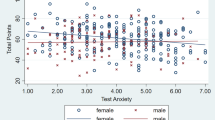Abstract
This paper compares the performances of female and male secondary students in the 1991 and 1992 Australian National Chemistry Quizzes. Male students consistently achieved a higher mean score in all Year groups (7 to 12), even though the numbers of female and male entrants were approximately equal. Implications for class tests and assessment tasks are addressed.
Similar content being viewed by others
References
Beard, J.H., Fogliani, C.L., Owens, C. & Wilson, A. (1992).Multiple choice chemistry questions categorized according to Bloom's taxonomy. Senior Years 11 & 12. Bathurst: CASAC.
Beard, J.H., Fogliani, C.L., Owens, C. & Wilson, A. (1992).Multiple choice chemistry questions categorized according to Bloom's taxonomy. Junior Years 7–10. Bathurst: CASAC.
Bloom, B.S. (Ed.) (1956).Taxonomy of educational objectives. The classification of educational goals. Handbooks 1 & 2. New York: Longmans.
Dekkers, J., & De Laeter, J.R. (1993). Chemistry enrolments in Australian secondary schools,Chemistry in Australia.60(2), 76–77.
Gardner, P.L. (1974). Sex differences in achievement, attitudes, and personality of science students: a review.Research in Science Education.4, 231–258.
Harding, J. (1979). Sex differences in objective test performance.Physics Education, 14, 280–284.
Head, J. (1985).The personal response to science. Cambridge: Cambridge University Press.
Jones, C. (1993). School gender bias eases but girls still at a disadvantage.The Weekend Australian, April, 3–4, 44.
Murphy, R.J.L. (1978). Sex differences in examination performance: do these reflect differences in ability or sex-role stereotypes?Educational Review, 30(3), 259–263.
Rae, I.D. (1993). Gender differences in responses to multiple-choice items in senior secondary chemistry examinations.Chemeda: The Australian Journal of Chemical Education. (37), 3–6.
Rennie, L.J., & Parker, L.H. (1991). Assessment of learning in science: the need to look closely at item characteristics.The Australian Science Teachers Journal, 37(4), 56–59.
Rosier, M. (1988). Sex differences in science achievement.Unicorn, 14(4), 274–276.
Shuard, H. (1986).Primary mathematics today and tomorrow. York: Longman and School Curriculum Development Committee.
Sjoberg, S. (1990). Gender equality in science classrooms.What Research Says to the Science and Mathematics Teacher, 6. The Key Centre for School Science and Mathematics, University of Technology, Perth, Western Australia.
Woolnough, J.A. & Cameron, R.S. (1991). Girls, boys and conceptual physics: an evaluation of a senior secondary physics course.Research in Science Education, 21, 337–344.
Author information
Authors and Affiliations
Additional information
Specializations: chemical education, environmental science.
Specialization: chemical education
Specializations: chemical education, analytical chemistry.
Rights and permissions
About this article
Cite this article
Beard, J., Fogliani, C., Owens, C. et al. Is achievement in Australian chemistry gender based?. Research in Science Education 23, 10–14 (1993). https://doi.org/10.1007/BF02357039
Issue Date:
DOI: https://doi.org/10.1007/BF02357039




